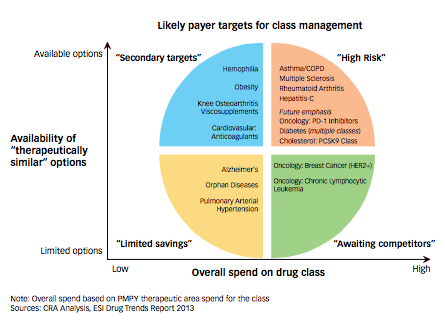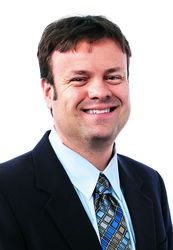Restricted Access Essentials for Pharma
Pharmaceutical Executive
Where is US payer formulary management heading-and what can the industry do to help influence its course?
Drug prices continue to grab headlines in healthcare industry news. Among innovative therapies, products for hepatitis C virus; cystic fibrosis; cholesterol, such as PCSK9 inhibitors; and advanced melanoma have garnered press for both the cost per treatment and impact on total pharmacy spend. Price increases on existing products have also been noted, with particular spotlights on diabetes and multiple sclerosis therapies.
Over the past 18 months, payers have accelerated their response, wielding the leverage of national formularies to extract higher manufacturer rebates and further restricting product options to create cost savings; this trend may become even more pronounced with further payer consolidation. Here are four questions US drugmakers must answer to cope with this evolving payer landscape:
Which drug classes will payers target next with restrictive formularies?
Payer effectiveness in controlling access dictates their ability to extract higher rebates from manufacturers and limit cost increases. Though both of the leading pharmacy benefit managers (PBMs), CVS Health and Express Scripts, have reported significant savings stemming from their more restrictive formularies, success has varied by drug class. Going forward, expect two main factors to inform which drug classes payers may target for more restrictive management:
- Drug classes with high current spend or expected to have high future spend.
- Drug classes with multiple current or anticipated “therapeutically similar” options, which may be due to new product entries, biosimilar entries, or both.

The following are three major drug classes where pricing competition will play a key role in determining the overall financial value of the class and the ultimate winners and losers:
Cholesterol (PCSK9 class)
The new class of PCSK9 inhibitors is highly anticipated and projected to garner up to $10 billion in sales annually. Regeneron/Sanofi and Amgen each plan to launch one of these products in 2015, with Pfizer also in hot pursuit. Payers may characterize these products as “therapeutically similar options” and force a competition for formulary status from the outset. Payers are already suggesting that their reactions to the higher-than-expected pricing of the PCSK9 class could emulate their reactions to the pricing of the new hepatitis C products, although the actual payer management approach may differ.
Diabetes (Basal analog insulin class)
While payers have historically maintained relatively open access in basal analog insulins (Sanofi’s Lantus and Novo Nordisk’s Levemir), this drug class is becoming significantly more competitive. Sanofi recently launched Toujeo and potential near-term market entrants include Novo Nordisk’s Tresiba as well as multiple biosimilar glargines (e.g., from Eli Lilly and Merck). The upcoming evolution of payer formularies may show the extent to which payers attempt to position biosimilars, current products, and next-generation products as therapeutically similar. Additionally, the biosimilar glargine launches may provide insights regarding the extent to which anticipated biosimilar launches in other drug classes place branded reference products and their branded competitors at risk.
Oncology (PD-1 inhibitor class)
In September 2014, Merck’s Keytruda was the first of many PD-1 inhibitors in development to be approved. At a cost of over $140,000 per year of therapy, and with sales of the class projected to reach $32 billion by 2025, payers are likely to step up their response. Competition has increased with the approval of Bristol-Myers Squibb’s Opdivo in late 2014. Express Scripts has already indicated an interest in managing the class, particularly as more indications are approved for each of these products and more entrants (Roche, AstraZeneca, etc.) are looming. This would represent a game-changing move toward more active management of budget-straining oncology products, which, historically, have been allowed to coexist on payer formularies due to management complexity and risk of provider and patient dissatisfaction.
Which types of payers are most likely to move toward restrictive formularies?
CVS Health and Express Scripts have led the movement toward more restrictive formularies. Smaller PBMs, such as Catamaran (prior to the OptumRx acquisition), have followed their lead, and some health plans have followed suit in specific drug classes (e.g., Humana and Harvard Pilgrim in hepatitis C). It remains to be seen how widespread this trend will become. Three segments of payers are likely to emerge:
- Payers that actively manage and favor the lowest-cost products.
Some payers will seek the lowest-cost products in a broad array of drug classes by using a more inclusive definition of “therapeutically similar.” Such payers may be characterized by high economies of scale, ability to effectively implement restrictions and control share, and a corporate value proposition that emphasizes client cost savings.
- Payers that actively manage and favor the “better” products.
Some health plans may actively manage certain drug classes, but prefer products they view as better clinical options. These payers will also group similar options together into “market baskets” and choose one product in each market basket for preferred formulary position. In classes where they perceive enough differentiation in terms of efficacy, safety, and/or clinical outcomes, they will select the “better” options.
- Payers that prefer to offer multiple options.
A smaller segment of payers may continue to provide relatively open access in many drug classes, citing an unproven link between pharmacy benefit savings and overall healthcare savings, concerns regarding disruptions to patient therapy, concerns about quality of care and clinical outcomes, and insufficient formulary management tools.
A major stakeholder group influencing the prevalence of restrictive formularies is employers. Payers compete for employer business, and employers fall along a broad spectrum with respect to their preference for cost savings vs. quality and choice for their employees. Monitoring trends in employer perspectives will be instructive in gauging how the three payer segments may evolve in the future.
What does this mean for manufacturer strategies?
Manufacturers with strong brands can win in an open-access environment. However, as some drug classes have become saturated, late-to-market entrants and some manufacturers with clinically undifferentiated or inferior brands have embraced the trend toward narrow payer formularies. Gaining a preferred formulary position with price-based strategies could be a springboard to market share growth that would be otherwise unattainable. With the prospect of significant share gains, manufacturers of these brands would be expected to negotiate aggressively, particularly when encouraged by payers.
Of course, payers often have an ulterior motive in leveraging other manufacturers as “credible threats” to extract better pricing terms from market-leading brands. When this situation occurs, market-leading brands face difficult decisions. They could respond and protect their position by offering price concessions, or they could face the risk of share loss. Their strategic evaluation will vary by drug class, and should consider the following questions:
- What price will it take to maintain or regain access?
- How much share is at risk?
- Is it possible to activate other stakeholders to influence payer access decisions?
- Can their brand still succeed while in a disadvantaged access position?
- How will their strategy impact competitor actions and bidding strategy in the future?
How can manufacturers optimize access for their products?
Manufacturers, particularly those with new, innovative products, should consider the following steps to enhance the likelihood of payer receptivity to their offering.
Product-level strategies focused on building and communicating value
- Develop multi-stakeholder engagement plans to communicate clinical need and mitigate market reactions to price.
- Build cost effectiveness evidence that encourages payers to view products in terms of impact on overall cost of care, rather than only unit price.
- Design segmented pricing strategies, identifying high- and low-value customers and tailoring an approach that explicitly considers expected competitor response to preserve price discipline where possible and to optimize the impact of price concessions where necessary.
- Explore alternative pricing methods that emphasize clinical outcomes and leverage creative ways to deliver value to payers.
- Engage in realistic simulations to guide competitive response strategy and improve the skill with which the pricing strategy is implemented.
Industry-level strategies focused on linking access to outcomes
- Broadly promote the benefits of open access to employer groups, key opinion leaders (KOLs), providers, and patient organizations to influence payer access decisions.
- Develop supporting clinical evidence for continuity of care associated with open access, which could include improvements in adherence, patient satisfaction, and overall outcomes.
Strategic outlook for manufacturers
Manufacturers should expect payers to increasingly restrict drug classes in response to price pressures and other industry trends. By looking at total spend and availability of therapeutically similar alternatives, manufacturers can identify likely payer cost savings targets. However, they should not expect all payers to follow the trend towards more restrictive formulary management, particularly as emerging healthcare trends include patient-centricity, continuity of care, and overall clinical outcomes. Manufacturers may have opportunities to influence future formulary decisions by developing strategies that identify key segments and stakeholders, and take advantage of leverage points in the payer space.

Lev Gerlovin is a consultant with the Life Sciences Practice at Charles River Associates. He can be reached at lgerlovin@crai.com. Ezra Josephson, formerly with Charles River Associates, also contributed to this article.
* The views expressed herein are those of the author.

FDA Grants Priority Review to Regeneron’s Eylea for Macular Edema Following Retinal Vein Occlusion
April 18th 2025Regulatory action was based on data from the Phase III QUASAR trial, which demonstrated that Eylea HD dosed every eight weeks achieved non-inferior visual acuity outcomes compared to Eylea in patients with macular edema following retinal vein occlusion.
Navigating Distrust: Pharma in the Age of Social Media
February 18th 2025Ian Baer, Founder and CEO of Sooth, discusses how the growing distrust in social media will impact industry marketing strategies and the relationships between pharmaceutical companies and the patients they aim to serve. He also explains dark social, how to combat misinformation, closing the trust gap, and more.